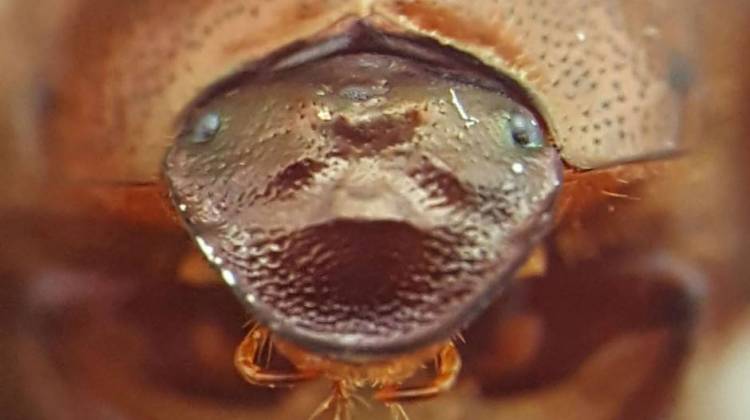
The researchers were able to induce a third eye on the top of the beetles' head during their development.
Sophia Saliby/WFIUA team of IU biologists says an accidental discovery made while studying dung beetles could have huge implications for the way scientists study the evolutionary beginnings of certain traits.
Indiana University biologist Armin Moczek describes the horned dung beetles he studies as resembling small, little coffee beans. They look just like regular beetles with six little legs and a shiny black body, but it’s their third eye that makes them special.
“It turns out that this eye is fully functional. It’s in the wrong place. It’s not a perfect eye, but it’s perfect enough to see,” he says.
That extra eye was a surprise discovery Moczek’s team found after interfering with the insect’s genetic material during its development. So instead of a horn that typically develops in the middle of the head, the beetle has a third eye.
The team injected RNA into the beetles during their larval stage. That injected RNA corresponded with the beetle’s own genetic material but targeted one specific gene the researchers wanted to deactivate.
“You use their own defenses to silence one of their genes,” he says.
And this process didn’t just work with one beetle, the researchers replicated the results with many different species of dung beetles.
“The hypothesis is created that because beetles early on in their evolution lost their extra type of eye called ocelli, it may have opened up the developmental genetic machinery that used to be responsible for making that eye to do something new, like make a horn,” Moczek says.
So the horns on the beetles’ heads didn’t necessarily evolve from that extra eye but its loss freed up the ability for the beetle to develop a new structure on its head, like the horn.
Following that evolutionary trail is the next step for the researchers, as well as figuring out why this specific genetic manipulation works in these beetles but doesn’t for other less closely-related species.

 DONATE
DONATE







 Support WFYI. We can't do it without you.
Support WFYI. We can't do it without you.